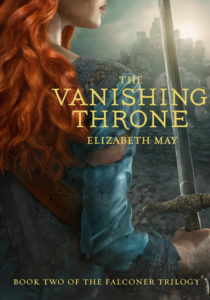
Elizabeth May
Chronicle Books
Published on June 21, 2016

Amazon | Barnes & Noble | Goodreads
About The Vanishing Throne
Everything she loved is gone.
Trapped. Aileana Kameron, the Falconer, disappeared through the fae portal she was trying to close forever. Now she wakes in an alien world of mirrors, magic, and deception—a prisoner of the evil fae Lonnrach, who has a desperate and deadly plan for his new captive.
Tortured. Time after agonizing time Lonnrach steals Aileana’s memories, searching for knowledge to save his world. Just when she’s about to lose all hope, Aileana is rescued by an unexpected ally and returns home, only to confront a terrifying truth. The city of Edinburgh is now an unrecognizable wasteland. And Aileana knows the devastation is all her fault.
Transformed. The few human survivors are living in an underground colony, in an uneasy truce with a remnant of the fae. It is a fragile alliance, but an even greater danger awaits: the human and fae worlds may disappear forever. Only Aileana can save both worlds, but in order to do so she must awaken her latent Falconer powers. And the price of doing so might be her life…
My Review
After I read the first book in The Falconer series, I couldn’t wait to read this one. Somehow it still took me like two years to do it, though. Oops.
What I loved: witty banter between characters, and one new character in particular. I loved Kiaran’s sister. She’s not at all like the stereotypical fae with the moodiness or aloofness. She has this open curiosity and goofy sense of humor but still feels like a member of the fae somehow. I liked her a lot. I also really enjoyed Aileana’s friend, a pixie named Derek. I’d forgotten all about him between books, but once he came back on the scene, I was hooked all over again.
The romance element remains strong and some very interesting plot twists place a lot of obstacles between Aileana and her happily-ever-after. Some of those twists took me completely by surprise, but they made so much sense looking back. I love when a story has a turning point like that, where it makes you go back and see all the earlier parts differently.
One thing that I kind of missed from The Falconer is that Aileana used to be much more concerned with propriety. She makes sure to have boundaries in her relationships with men. In this book, she has no thought for boundaries or her future. Some of that makes perfect sense, since the story has a much more post-apocalyptic feel, so it would be weird if her feelings about her future didn’t change. I guess there wasn’t really a point where she evaluated her beliefs and changed. She kind of just gets swept up in her relationship with Kiaran and never appears to think about any consequences to her actions. It wasn’t a huge deal in the story, but for anyone who read the first book thinking the series wouldn’t have any sex in it because of the time period it’s set in and Aileana’s personal beliefs, just know that isn’t true.
Reading Vanishing Throne made me super interested in reading the series finale, Fallen Kingdom. I love the strong heroine and the memorable characters, so I’m definitely eager for more. The series is a great pick for fans of Julie Kagawa.
Cultural Elements
The story is set in Scotland, so most characters are white and upper class.
Profanity/Crude Language Content
Mild profanity used very frequently. A few instances of stronger curses.
Romance/Sexual Content
Kissing between man and woman. One scene shows them undressing and going to bed together. It’s obvious they have sex but not graphically described.
Spiritual Content
The story contains faeries and monsters who possess magic. Some humans have specialized abilities which allow them to sense faeries or resist their magic. Some fae have an alliance with humans and use magic to protect them.
If a human dies and comes back to life, they may return with the ability to see the Fae. It can also unlock other gifts.
Violent Content
Battle scenes with some descriptions of injuries. Aileana is captured by fae at one point and tortured. Mostly her torture is mental. For instance, eventually, the isolation becomes a huge burden and she becomes eager for her captor’s visits. He bites her repeatedly, and his venom causes some additional pain.
Drug Content
Fae bites inject a venom that humans find addicting. At one point, a small group sit together drinking whiskey.